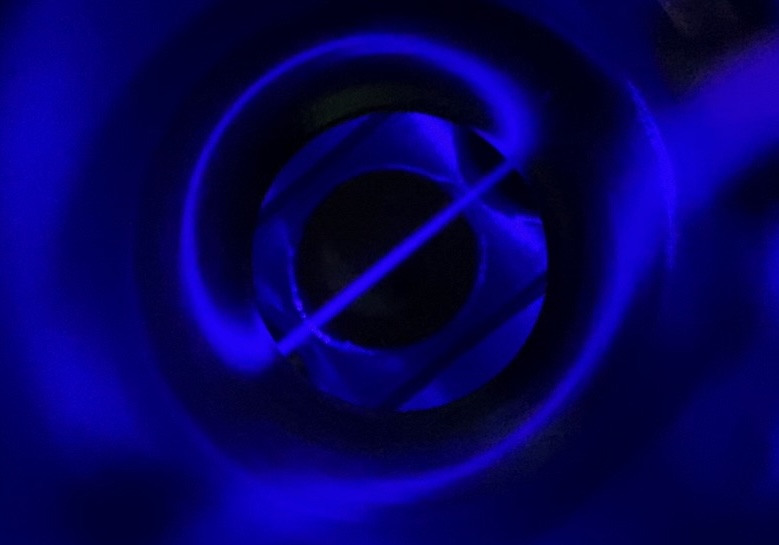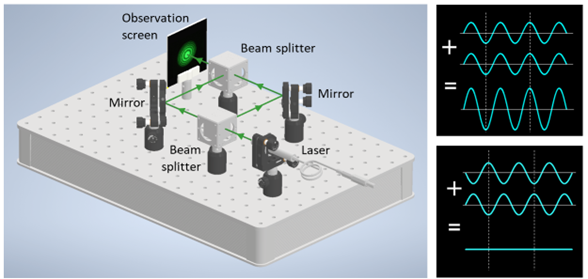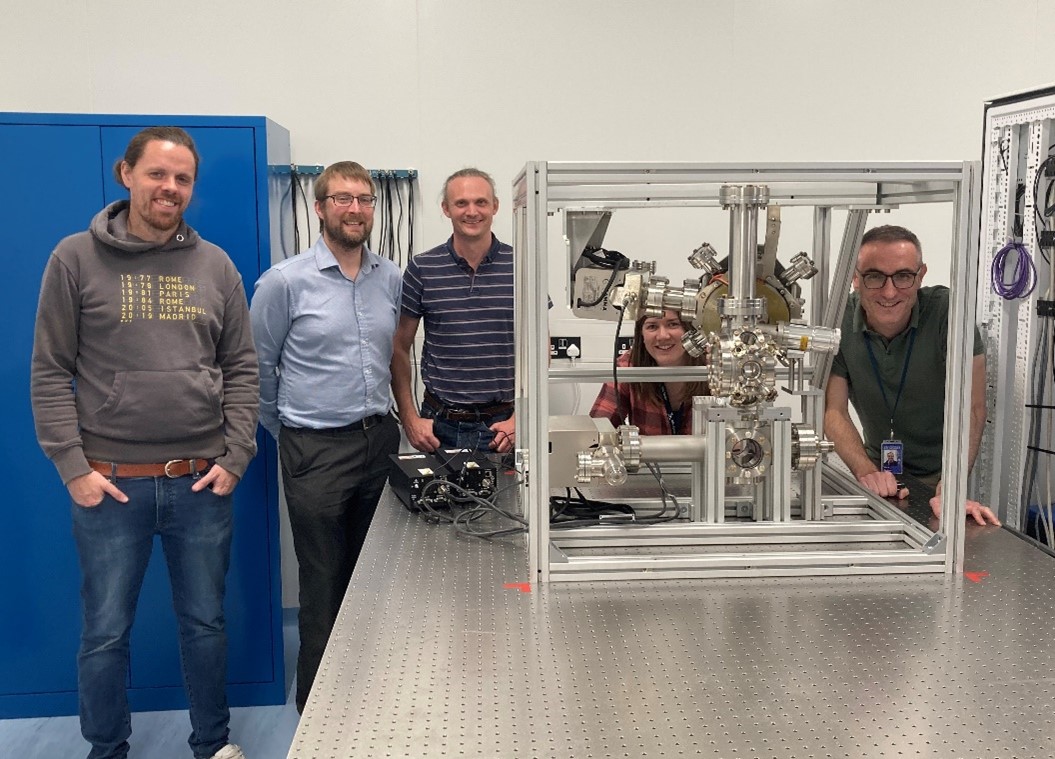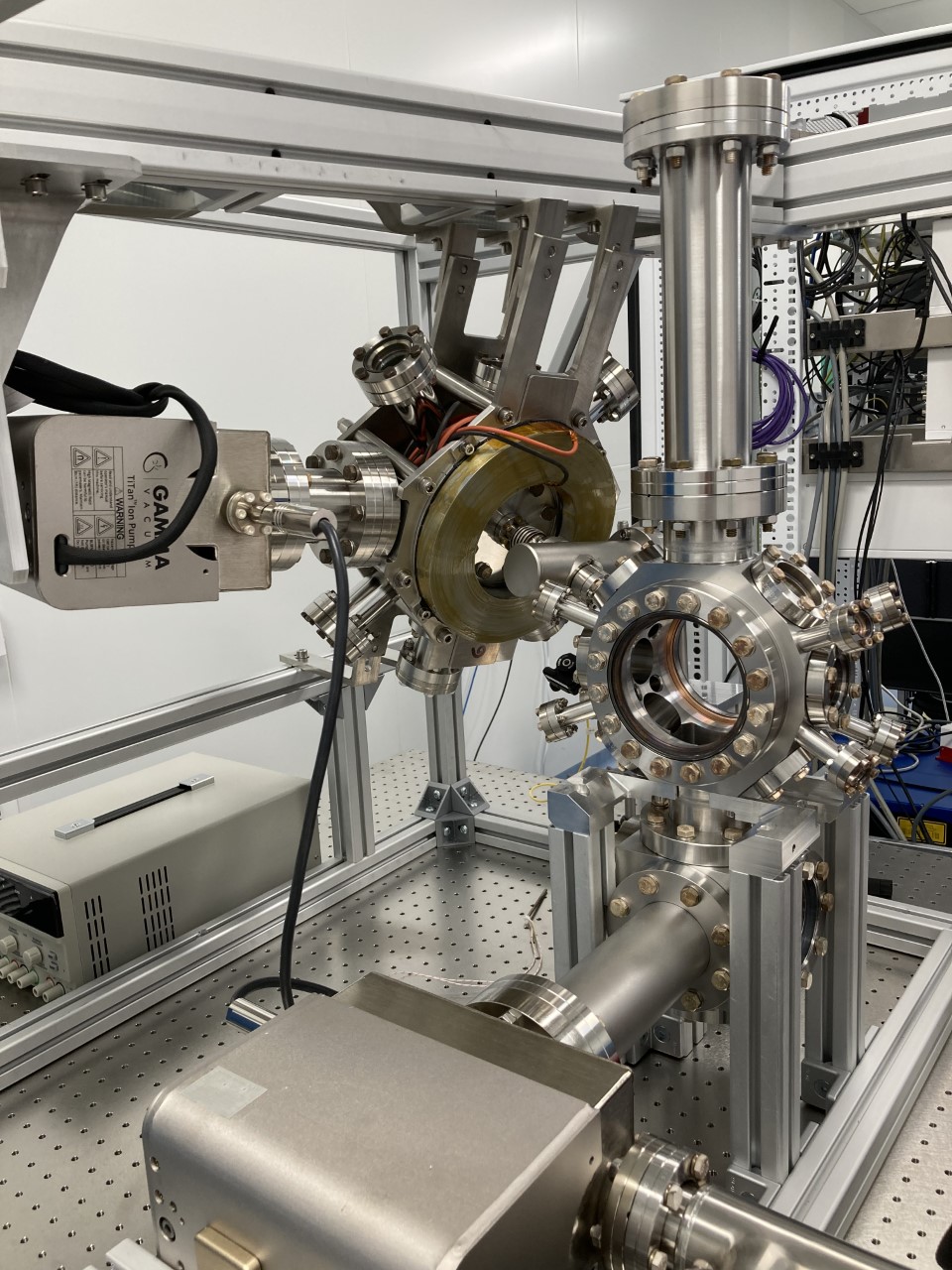The AION project brings together STFC's RAL Space, Particle Physics and Technology departments, along with the Universities of Oxford, Cambridge, Birmingham and Liverpool, King's College and Imperial College, London.

Fluorescence of strontium atoms emitted from the oven, observed through a vacuum viewport. A laser beam operating at 461nm is passed though the chamber, exciting atoms and causing them to fluoresce blue, leading to the stripe seen at the centre of the image.
Historically, the development of astronomy has been linked to the development of optics. For example, the development of the Dutch telescopes led to detailed studies of our Moon and those of Jupiter. Nowadays, astronomers explore a vast part of the electromagnetic spectrum in the pursuit of new insights, and in the last 10 years, they have had a new tool at their disposal: In 2015, the LIGO collaboration detected gravitational waves – ripples in spacetime generated by two colliding black holes – for the very first time.
Since then, we have detected over 20 of these binary-merger events, and excitingly, these are just the tip of the iceberg. Just like the electromagnetic spectrum, gravitational waves exist at various frequencies with tell-tale signatures of activity. Detecting these phenomena will rely on the development of new gravitational wave detectors, an example being the Laser Interferometer Space Antenna – LISA – due to launch in 2034.
Interferometry is a way of carrying out extremely sensitive measurements using the interference of waves. Superimposing two waves creates an interference pattern which can be precisely measured. When combined, the peaks and troughs of the waves add up to give constructive or destructive interference, leading to bright and dark fringes in the pattern.
In a typical optical interferometer, light is split into two paths using an optical component such as a beamsplitter, directed using highly reflective mirrors, and then recombined with a second beamsplitter (see image). Any difference in the two path lengths results in a mismatch of the light waves when they are brought back together, changing the interference pattern observed.

Optical
interferometry: (Left) In a typical optical interferometer, light is split into
two paths using a beam splitter. These two paths are then brought together
using mirrors and recombined on a second beam splitter. By superimposing the
two paths an interference pattern is created, typically made up of bright and
dark fringes. (Right) Bright fringes correspond to the two light waves arriving
in phase, aligning peak to peak and trough to trough (top). In contrast, dark
fringes occur when the waves arrive completely out of phase (bottom).
By operating in this quantum regime, we can exploit properties of the atoms not usually accessible to us in our classical world. Crucial to the AION interferometer's operation is the use of quantum superposition, where the atoms effectively exist in two places at once. This allows us to create our two interferometer paths by putting atoms in two different atomic states at the same time. To do this, laser pulses are used to transfer the atoms in the cloud from their usual 'ground' state to a more energetic, 'excited' state. Importantly for AION, this beamsplitting stage in strontium can be done using only one laser frequency to transfer atoms between states. This is critical to the operation of the AION detector as it ensures a key source of uncertainty associated with the interferometry lasers can be eliminated from the experiment.
By comparing two interferometers spaced far apart, it is possible to looks for differences in their measured phases, indicative of gravitational wave activity or the presence of dark matter fields. For the initial AION-10 detector, two interferometers will be used, spaced roughly 5m apart, attached to a 10m vacuum tube. This will be constructed in the basement of the Physics Department at the University of Oxford where the system will be developed and characterised to guide the next stage of design work for a 100m long device.
Currently the Quantum Sensors group at RAL Space is working on the development and optimisation of the ultracold strontium atom source, laser cooling atoms inside an ultrahigh vacuum chamber to protect them from the environment (see image). As strontium is a solid at room temperature, it has to be heated to around 400-500°C to produce a gaseous vapour in the oven chamber of the vacuum system. The atoms in the gas are then laser cooled in two stages, first using blue light and then red. In this process, an atom travelling towards a laser beam can absorb some of the laser light. This gives the atom a tiny momentum kick in the direction of the laser beam and excites the atom to a more energetic state. Sometime later, the atom will re-emit the light back out again, but in a random direction. By doing this thousands of times, the tiny kicks add up and the atom starts to slow down as it is pushed backwards by the laser beam. This slowing down is equivalent to making the atoms colder. If we do this with multiple laser beams (typically six) the atoms are effectively pinned in all directions and, by adding a magnetic field, can be trapped where the beams intersect.

Ultrahigh vacuum system delivery: The atoms used for the interferometer are produced under ultrahigh vacuum condition to isolate them from the environment. The vacuum systems used by AION were constructed by colleagues as Daresbury Laboratory and delivered to each institution. L-R: Adam Lowe (Uni. Of Oxford), Andrew Vick (DL), Ian Wilmut (RAL- TD), Anna Marchant (RAL Space), Mark Bason (RAL Space).
The goal of this first round of development is to produce the largest possible cloud of atoms, at the coldest temperature, in the fastest time. As of October 2022, fluorescence from the strontium atoms in the RAL chamber has been observed (see image) and work is underway to begin the first laser cooling stages. Stay tuned for further developments!

The RAL Space vacuum system. To the left of the image is the first chamber where atoms are heated to 400-500°C, before being cooled and 'pushed' into the second chamber where they are collected and cooled further.
